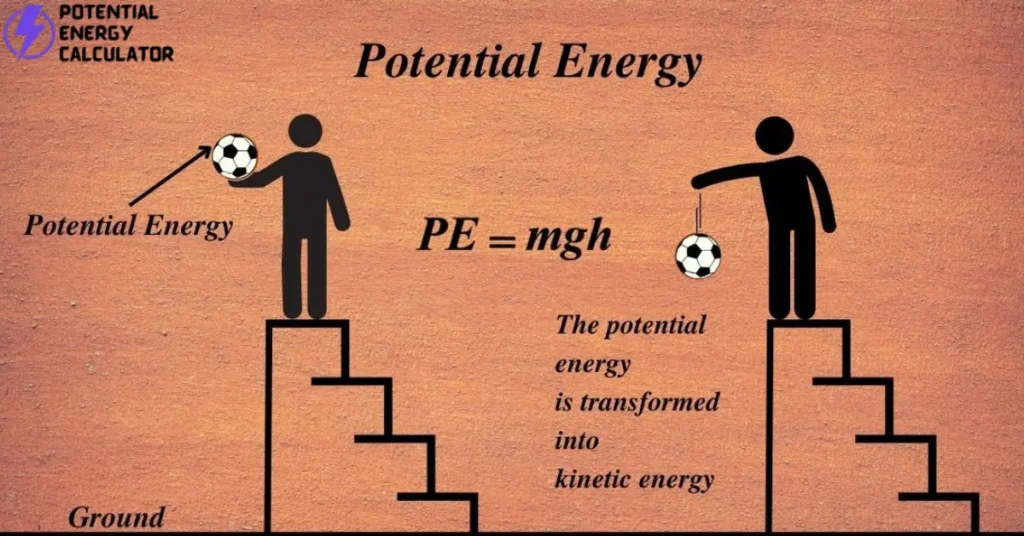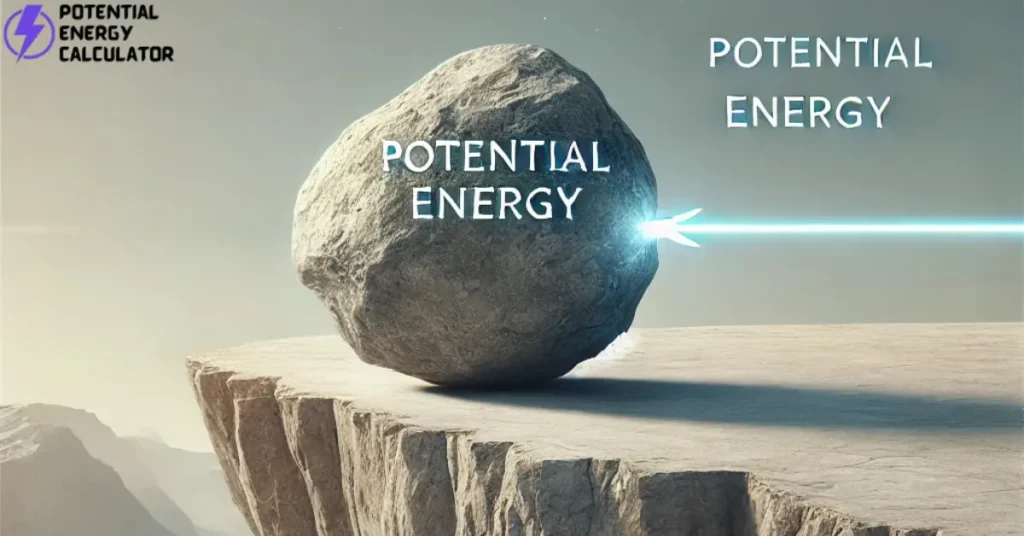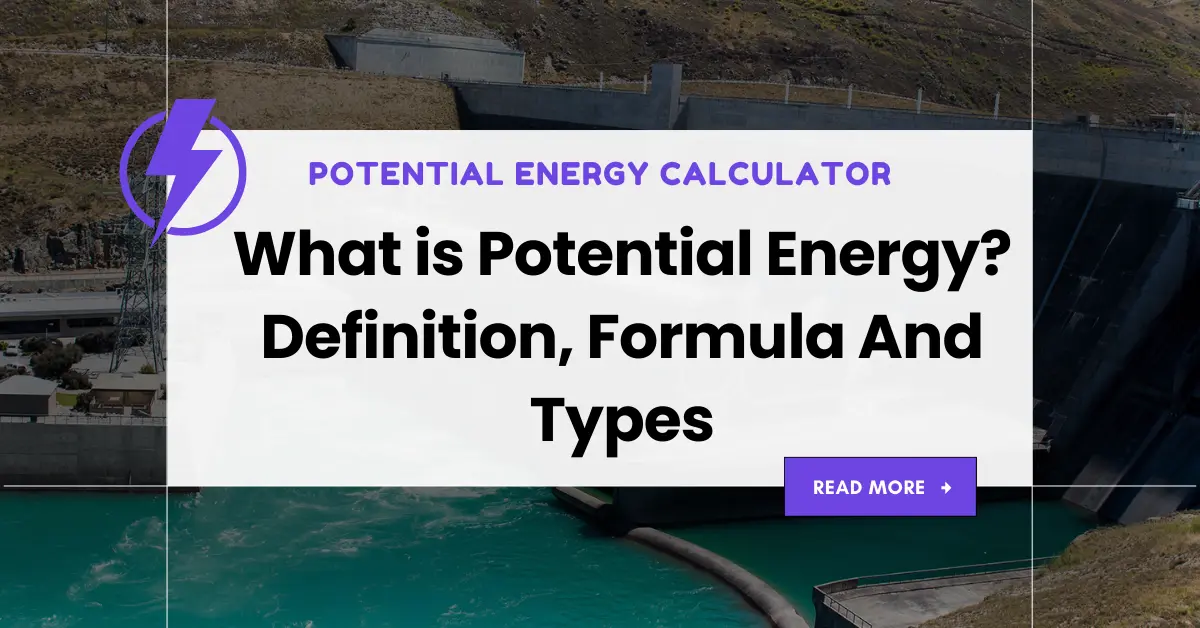Potential energy is the energy stored in an object due to its position, shape, or condition. It is called “potential” because it has the capacity to be converted into kinetic energy or other forms of energy.
Definition Of Potential Energy
What is Potential Energy?
Energy is everywhere. From the food we eat to the fuel that powers our vehicles, energy exists in many forms. Among these, potential energy is one of the most fundamental types. But what exactly is potential energy?
Potential energy is the stored energy an object possesses due to its position, shape, or state. Unlike kinetic energy, which is energy in motion, potential energy remains dormant until it is released or converted into another form.
For example, a stretched rubber band, a rock on a cliff, and water held behind a dam all possess potential energy. Understanding this concept is crucial in physics, engineering, and even daily life.
In simple terms, any object that can do work due to its stored energy has potential energy.
💡 Example: A ball held at a height has potential energy due to gravity. When released, this energy transforms into kinetic energy as the ball falls.
Real-Life Examples of Potential Energy
To easily understand potential energy, here are some examples from our daily life where it plays a role:
- A Stretched Spring:
- When a spring is compressed or stretched, it stores elastic potential energy.
- When released, this energy turns into motion.
- A Roller Coaster at the Peak
- At the highest point, the coaster has maximum gravitational potential energy.
- As it descends, the energy converts into kinetic energy, making it accelerate.
- At the lowest point, the Roller Coaster has maximum Kinetic Energy.
- Water Stored in a Dam
- The water at a height holds gravitational potential energy.
- When released, it turns into kinetic energy, generating electricity in turbines.
- A Battery
- A charged battery has chemical potential energy stored inside.
- When connected to a device, it transforms into electrical energy.
- A Bow and Arrow
- When an archer pulls the bowstring, elastic potential energy is stored.
- Releasing it converts this energy into kinetic energy, propelling the arrow.
These examples show how potential energy exists all around us, waiting to be converted into useful work.

Formula of Potential Energy
Potential energy depends on an object’s mass, height, and gravitational acceleration. The general formula for gravitational potential energy is:
U = mgh
P.E = mghWhere:
- U = Potential Energy (Joules, J)
- m = Mass of the object (Kilograms, kg)
- g = Acceleration due to gravity (9.81 m/s² on Earth)
- h = Height of the object from a reference point (Meters, m)
This formula applies when an object is positioned at a height and is influenced by gravity.
Example
A 5 kg object placed 10 meters above the ground has potential energy calculated as:
P.E. = 5 × 9.81 × 10
P.E. = 490.5 J
This means the object has 490.5 Joules of stored energy due to its height.
How to Calculate Potential Energy?
Follow these simple steps to calculate the potential energy of an object:
- Identify the mass of the object (m) in kilograms.
- Determine the height from a reference point (h) in meters.
- Use the standard gravitational acceleration (g = 9.81 m/s²) unless stated otherwise.
- Apply the formula:
PE = mgh - Solve the equation to get the answer in Joules (J).
Example Calculation
A 15 kg box is placed 5 meters above the ground.
- Given: m = 15 kg, g = 9.81 m/s², h = 5 m
- Formula:
PE = 15 × 9.81 × 5PE = 735.75 J - Answer: The box has 735.75 Joules of gravitational potential energy.
👉 Want to calculate Potential Energy instantly? Use our Potential Energy Calculator to get instant results without manual calculations within few seconds!

Types of Potential Energy
Potential energy is categorized based on how energy is stored. Here are its main types:
1. Gravitational Potential Energy (GPE)
- Gravitational Potential Energy is stored in an object due to its height above the ground.
- Formula:
G.P.E. = mgh - Example: A rock at the edge of a cliff.
2. Elastic Potential Energy (EPE)
- Elastic Potential Energy is the energy stored when an object is stretched or compressed.
- Formula:
E.P.E. = ½ kx²(where k = spring constant, x = displacement) - Example: A stretched rubber band.
3. Chemical Potential Energy
- Chemical Potential Energy is stored in chemical bonds that is released during a reaction.
- Formula: No Specific Formula
- Example: Fuel, batteries, and food.
4. Nuclear Potential Energy
- Nuclear Potential Energy is the stored energy in the nucleus of an atom, released during nuclear reactions.
- Formula: No specific Formula
- Example: Nuclear power plants.
5. Electrical Potential Energy
- Electrical potential Energy is the stored energy due to the position of charges in an electric field.
- Formula: U = k (q₁q₂) / r
- Example: A charged capacitor.
Each type of potential energy plays a vital role in physics and real-world applications.
P.E of Different Objects
| Object | Type of Potential Energy | Example Calculation |
|---|---|---|
| Water in a Dam | Gravitational | PE = mgh |
| Stretched Rubber Band | Elastic | PE = ½ kx² |
| A Charged Battery | Chemical | Converts into electrical energy |
| A Lifted Brick | Gravitational | PE = mgh |
| Compressed Spring | Elastic | PE = ½ kx² |
Potential Energy Units
| Unit Name | Symbol | System Used |
|---|---|---|
| Joule | J | SI (International System) |
| Newton-Meter | N·m | Equivalent to Joule |
| Electron Volt | eV | Atomic and nuclear physics |
| Calorie | cal | Used in food energy |
| Foot-Pound | ft·lbf | Imperial system |
Solved Problems of Potential Energy For Practice
Here are five detailed numerical problems, with step-by-step solutions.
Problem 1: Potential Energy of a Hanging Object
Question: A 10 kg object is hanging from a height of 8 meters. Calculate its gravitational potential energy.
Solution:
Given:
- Mass (m) = 10 kg
- Height (h) = 8 m
- Gravitational acceleration (g) = 9.81 m/s²
Using the formula:
PE = mgh
PE = 10 × 9.81 × 8
PE = 784.8 J
Answer: The object has 784.8 Joules of potential energy.
Problem 2: Potential Energy of Water Stored in a Dam
Question: A dam holds 5000 kg of water at a height of 50 meters. Find its gravitational potential energy.
Solution:
Given:
- Mass (m) = 5000 kg
- Height (h) = 50 m
- Gravitational acceleration (g) = 9.81 m/s²
Using the formula:
PE = mgh
PE = 5000 × 9.81 × 50
PE = 2,452,500 J
Answer: The water in the dam has 2,452,500 Joules of potential energy.
Problem 3: Potential Energy of a Book on a Shelf
Question: A book with a mass of 2 kg is placed on a shelf that is 3 meters high. What is its potential energy?
Solution:
Given:
- Mass (m) = 2 kg
- Height (h) = 3 m
- g = 9.81 m/s²
Using the formula:
PE = mgh
PE = 2 × 9.81 × 3
PE = 58.86 J
Answer: The book has 58.86 Joules of potential energy.
Problem 4: Potential Energy of a Roller Coaster at the Peak
Question: A roller coaster with a total mass of 1000 kg is at the highest point, 20 meters above the ground. Find its potential energy.
Solution:
Given:
- Mass (m) = 1000 kg
- Height (h) = 20 m
- g = 9.81 m/s²
Using the formula:
PE = mgh
PE = 1000 × 9.81 × 20
PE = 196,200 J
Answer: The roller coaster has 196,200 Joules of potential energy.
Problem 5: Potential Energy of a Pendulum
Question: A 0.5 kg pendulum bob is raised to a height of 2 meters. Calculate its potential energy.
Solution:
Given:
- Mass (m) = 0.5 kg
- Height (h) = 2 m
- g = 9.81 m/s²
Using the formula:
PE = mgh
PE = 0.5 × 9.81 × 2
PE = 9.81 J
Answer: The pendulum bob has 9.81 Joules of potential energy.
These problems cover different real-life scenarios to help students understand how potential energy works. Each solution follows a step-by-step approach so that anyone can practice and learn easily.

Conclusion
Potential energy is one of the most essential concepts in physics. It helps explain how objects store energy based on their position, shape, or composition.
Understanding potential energy is crucial for students, engineers, and scientists. Whether you are studying physics or working with energy systems, this concept plays a vital role in various scientific fields.
This article was written by Dr. Evren Frost, a PhD in Physics and a passionate creator of student-friendly tools. His goal is to make learning physics easier through practical applications and interactive tools.
FAQs
Potential energy is the stored energy an object has due to its position, shape, or condition. It remains inactive until it is converted into another form, like kinetic energy.
The formula for gravitational potential energy is:P.E. = mgh
where m is mass (kg), g is gravity (9.81 m/s²), and h is height (m).
The five main types of potential energy are:
1. Gravitational – Due to height (e.g., a rock on a cliff).
2. Elastic – Due to stretch/compression (e.g., a spring).
3. Chemical – Stored in chemical bonds (e.g., fuel, batteries).
4. Nuclear – Stored in atomic nuclei (e.g., nuclear power).
5. Electrical – Stored in electric fields (e.g., a capacitor).
Not always. An object must have height, tension, charge, or a chemical state to possess potential energy. A ball on the ground has no potential energy, but a ball placed on a table does.
Yes, potential energy can be negative when measured below a reference point. For example, in physics problems, when an object falls below ground level, its potential energy is negative relative to the surface.
It is converted into another form of energy, typically kinetic energy. Example: When a stretched rubber band is released, its stored energy converts into motion.
Greater mass means more potential energy. A heavier object at the same height has more stored energy than a lighter one.
Some common applications include:
1. Hydropower plants (water in dams).
2. Battery storage (chemical energy).
3. Springs in mattresses and vehicles (elastic energy).
4. Food storage (chemical potential energy).
It explains how energy is stored and transferred in various systems. It plays a major role in mechanical, electrical, and chemical processes.
Instead of manual calculations, use our Potential Energy Calculator for instant and accurate results.

